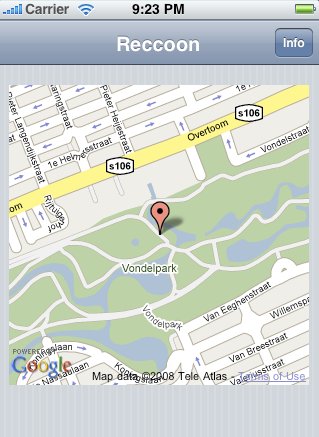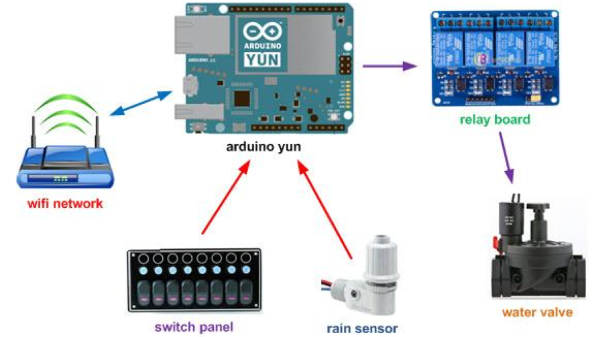We see lots of ESP8266 projects, but considerably fewer for the ESP32. So this good-looking weather station on a PCB using an ESP32 caught our eye. The board has a few sockets for common weather gear, but with a little modification, it would be a great carrier for an ESP32. Since the PCB layout is available, you could change things around to suit you. You can see a video from [Rui Santos] about his project and its progress from breadboard to PCB in the video below.
ajax5 Articles
Irrighino, An Arduino Yun Based Watering System
There are many different ways to keep your plants watered on a schedule. [Luca Dentella] just created a new one by building the irrighino watering system. He used standard off the shelf, hardware to keep it simple. Irrighino is a complete watering system based on the Arduino Yun, featuring a user friendly AJAX interface. This allows scheduling in a manner similar to creating appointments in Outlook. It’s also possible to manually control the various water solenoids. The code is fully customizable and open source, with code available from [Luca’s] github repository. The web interface is divided in to three tabs – “runtime” for manual control, “setup” to configure the scheduling, and “events” to view system logs.
The Arduino Yun activates solenoid valves via a relay shield. A switch panel has indicator Status LED’s and three position switches. These allow the outputs to be switched off or on manually, or controlled via the Yun when in auto mode. [Luca] describes how to read three states of the switch (On-Off-On) when connected to a single analog input of the Arduino. He’s also got another tutorial describing how to connect a USB WiFi adapter to the Yun. This is handy since the Yun is mounted inside an enclosure where the signal strength is very weak. While the Yun has on-board WiFi, there is no possibility to attach an external antenna directly to the test SMA socket.
One interesting part is the commercial rain sensor. It’s a switch surrounded by a spongy material. When this material absorbs rain water, it begins to expand and triggers the switch. The Arduino sees the sensor as a simple digital input.
Check a short demo of his system in the video after the break.
Continue reading “Irrighino, An Arduino Yun Based Watering System”
Web-enabled Kinect

There are Kinect hacks out there for robot vision, 3D scanners, and even pseudo-LIDAR setups. Until now, one limiting factor to these builds is the requirement for a full-blown computer on the device to deal with the depth maps and do all the necessary processing and computation. This doesn’t seem like much of a problem since [wizgrav] published Intrael, an HTTP interface for the Kinect.
[Eleftherios] caught up to [wizgrav] at his local hackerspace where he did a short tutorial on Intrael. [wizgrav]’s project provides each frame from the Kinect over HTTP wrapped up in JSON arrays. Everything a Kinect outputs aside from sound is now easily available over the Internet.
The project is meant to put computer vision outside the realm of desktops and robotic laptops and into the web. [wizgrav] has a few ideas on what his project can be used for, such as smart security cameras and all kinds of interactive surfaces.
After the break, check out the Intrael primer [wizgrav] demonstrated (it’s Greek to us, but there are subtitles), and a few demos of what Intrael ‘sees.’
Web Controlled Dark Crystal

[Reza] sent in his mood rock. Unlike other “mood” devices, instead of showing what mood you’re in, it shows what mood the internets are in. Two ShiftBrite modules are controlled by an AVR ATmega8 which then connects to a computer via USB. The assembly is placed inside of a piece of alabaster.
USB communications are controlled by the ATmega8 running V-USB (formerly AVR-USB) firmware. [Reza] wrote some code to control the colors from the web using Perl and AJAX. Head over to the web interface to set the colors yourself. We’d love it if a live webcam was added so we could see our mood on the rock itself. Continue reading “Web Controlled Dark Crystal”
Creating Web Applications For The IPhone

[Dominiek ter Heid] wanted to prototype an application for the iPhone that incorporated GPS. He experimented, and came up with a step-by-step tutorial on how to create a web application that would push GPS information to his iPhone through the use of JavaScript and AJAX. This tutorial will save web hackers who want to play with the iPhone 3G a lot of grief. Using Cocoa Touch, and a CSS/JavaScript pack called IUI, he successfully created a web application that looks native to the iPhone and is able to grab GPS information. The application integrates the GoogleMaps API with the GeoNames database. We look forward to seeing the types of creative applications that this prototype will inspire. What sort of web application would you want to create for the iPhone?
[via digg]













